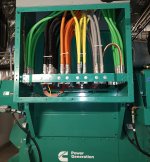- Location
- New Jersey
- Occupation
- Journeyman Electrician (retired)
Let's say that you have a large generator (SDS) that feeds a switchboard 30' away with 12 sets of 750 kcmil conductors. The SBJ is in the switchboard, would you have any EGC's in the raceways between the generator and the switchboard? I say no and the neutral in the generator must be bonded to the metal parts of the generator or would you have SSBJs in those raceways? Opinions?


